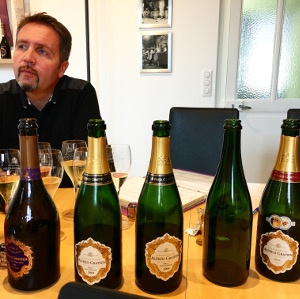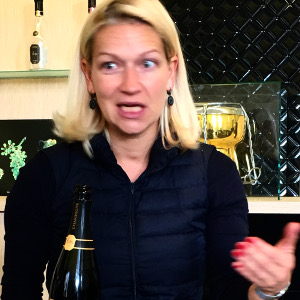
Even a house as august as Krug occasionally feels the need to reinvent itself. We were surprised upon arriving at Krug to find that the entrance had been completely reconfigured along with the completion of the new reception areas for guests and some ongoing work in the cellars. Even Krug, it seems, is not content to rest on its laurels.
Among the newer pieces of the Krug story is the rediscovery of Joseph Krug’s original notebook of his discussion with Hypollyte de Vivès, who was his backer as he broke off from his father-in-law at Jacquesson. Krug and de Vivès met in 1840; Joseph set up his own company in 1843. One can only imagine that it was a tumultuous time in his life. As we discussed Krug history old and new, we clarified that in 1972 Private Cuvée was changed to Grande Cuvée, that in 1971 the Clos de Mesnil was purchased with funds from the sale of Krug to Remy Cointreau, and that the vineyard was replanted and that the first vintage was 1979. There was little information to be gleaned about Krug Blanc de Blancs, shipped before the first Clos du Mesnil, or Krug Extra Sec. These, apparently, will remain a mystery.
Next we switched from former marketing stories to the current ones, and began to discuss the Krug ID This innovation, introduced with bottles disgorged in 2011, continues to fascinate, as the code on the back of the bottle allows Krug lovers to discover not only technical information such as the components of the blend, the date of disgorgement and other vital statistics, but also food and even pairings to accompany the wine. Luckily, this is more than gimmicky marketing: the wines are absolutely superb, and perhaps they have never been better in the houses’s long history.
Brut NV « Grande Cuvée » (163)
We began the visit with a glass of what is known as the 163rd edition of Krug Grande Cuvée. Our Krug ID (315051) tells us that this has a base from the year 2007, and that it is a blend of 37% Pinot, 32% Chardonnay and 31% Meunier, disgorged in the second quarter of 2015. The assemblage consists of 183 different blending components in total. On the nose there are the trademark coconut & saffron aromas, and the texture is silky and fine without sacrificing power or length. ****
Brut NV « Grande Cuvée » (160)
We concluded our visit with the 160th edition of « Grande Cuvée ». The Krug ID (214031) reveals that the blend is based on the 2004 vintage, that it is a blend of 44% Pinot Noir, 33% Chardonnay and 23% Meunier, and that there are 121 components in all, with 1990 as the oldest vintage in the blend. The wine was disgorged in 2012. The wine to me was silkier and more floral than the vintage wine from the same year – more approachable, really – which is logical with the use of older reserve wines. ****
Brut Vintage 2004
From the initial glass of Grande Cuvée we moved into the vintage wines, tasting first the 2004. This was lovely, citrusy and fresh with a very tender texture. It seemed, however, slightly closed, and at this stage it was almost too easy to love, and lacked perhaps a bit of tension. The nose revealed floral and toasty notes, but was not yet showing the depth of flavor I look for in Krug Vintage. Still, I think with time it will come around. The Krug ID (214041) paradoxically reveals that « Elle a reçu son bouchon au printemps 2014 » and that it « A quitté nos caves printemps 2014 ». This means that it was disgorged and shipped in the same season, which would be highly unusual for a house like Krug. I will investigate! The blend was 37% Pinot Noir, 39% Chardonnay, and 24% Meunier. *****
Brut Vintage 2002
From the ’04 we went on to the superb 2002. This showed a bit more maturity on the nose immediately, with the tropical fruit and coconut that I love in Krug vintage along with a suggestion of ground coffee and just a hint of black truffle. On the palate there is concentration and density but the character of the mousse is very silky and the length seems to go on forever. Stunning wine. I wonder what it will taste like out of magnum? Blend: 40% Pinot Noir, 39% Chardonnay, 21% Meunier. *****
We discussed the vintage wines a bit. Like 1988, the 2002 is first of a trilogy: 2002 – 2003 – 2004. This is highly unusual in the history of the house. We did not have an opportunity to taste the ’03 on this visit, but on my previous visit to the house it did not yet seem ready. Champagnes from hot years (think of 1982) can prove thrilling, but in my experience one needs to wait for them in order to enjoy them fully. Here the ’03 was shipped before the ’02 (which was release in the fall of 2015), just as the ’89 was shipped before the ’88. I have been a bit disappointed with both the ’89 and the ’03, and I think we’ll have to wait for them. I also think the ’04 is not yet showing at its full potential, but it is a wine full of promise. The ’02, perhaps a bit like the 1990, has always been there, and, one hopes, will continue to show well. We were told that there will not be any vintage wine produced in 2009 or 2012.


